Extraction Industry Primer | August 26, 2019
Patrick Smith | Analyst | Patrick@ubikaresearch.com
Chris Bednarz, MBA | Associate | Chris.B@ubikaresearch.com
John Brooker | Associate | John@ubikaresearch.com
Emma Widman | Associate | Emma@ubikaresearch.com
Ubika Alpha believes there is ample biomass available in 2020E to support a budding Canadian cannabis extraction industry
SmallCapPower | August 27, 2019: MediPharm Labs Corp. (TSX: LABS) Q4/18 results set-off a shift in the Canadian cannabis stocks from cultivators to pure-play extractors. The result being that cannabis extraction stocks have been outperforming the Top 5 Canadian cannabis companies during the past six months.
The combined annual biomass capacity of all publicly-listed extraction pure plays is ~1,405,000 kg.
- The Canadian biomass inventory published by Statistics Canada for the month of May 2019, was reported at 263,928 kg (finished and unfinished), a 22.3% MoM increase from April.
- There is plenty of new greenhouse/indoor space coming online within the next year. For example, it is estimated that 9M sq. ft will come online in southern BC (Vancouver Island, Lower Mainland, Okanagan) and 21.8M sq. ft coming online in Canada with the next year 1-2 years (Source: Financial Post).
- Note that, in our opinion, none of these processors are close to reaching full capacity, so we can amplify this point.
Vertically-integrated licensed cultivators, notably, any over a market cap of $1B, are not effectively equipped to support the high amount of biomass that is expected to come online in 2020E.
- Colorado and Washington in 2017 sold 115,249 and 17,976 kg, respectively, of extracts. Canada sold 66,786 kg from April 2018 to March 2019. Canada is only five years behind recreational legalization in these States.
- Many licensed cultivators are utilizing, or intend to use, C02 to process its own biomass. This is not ideal for processing biomass at scale. Since no public company is using butane yet, and to our estimation, most companies do not utilize an ethanol system as well. The U.S. market has proved that C02 is best for API purposes and higher-quality, expensive products, and that the majority of processing for scale is utilized by butane or ethanol.
Sales of dried flower are slowing
- Flower sales have slowed to an average growth rate of 8.0% over the last five months since legalization (Oct 17) while oil sales have grown at an average of more than 13.4% over the past five months.
- Retail stores have begun to operate but, in our opinion, are not even close to servicing the whole provincial markets.
- In general, the preference for consumers continues to be black-market dispensaries. We believe this supports the investment thesis for extraction companies, as the shelf life and quality of smoke/edible products are far easier than flower to standardize. As edibles reach the mainstream recreational market by year-end, we believe consumer behaviour will change.
To read our full disclosure, please click on the button below:




